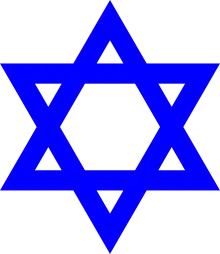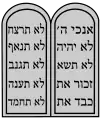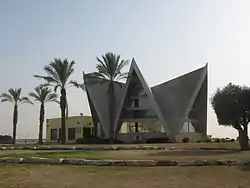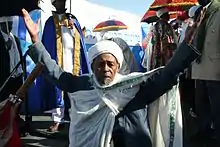Haymanot
Haymanot (Ge'ez: ሃይማኖት) is the branch of Judaism which is practiced by the Beta Israel, also known as Ethiopian Jews.
| Part of a series on |
| Judaism |
|---|
   |
|
In both Geʽez and Amharic, Haymanot means 'religion' or 'faith.' Thus in modern Amharic, it is common to speak of the Christian haymanot, the Jewish haymanot or the Muslim haymanot. The term is only associated with a particular religion (Judaism) in Israel.
Religious leaders
- Nabiyy (Prophet), related to the Arabic and Hebrew words nabī and nevi, used in Jewish and Islamic writing to refer to prophets.
- Monkosa (Monk), related to the Greek word monakhós, which means "alone, solitary."
- Kahen or Kes (Priest) – spiritual leader, similar to a Kohen and analogous to a Rabbi.
- Liqa Kahnet (High Priest)
- Debtera –
- Shmagle (elder) –
Texts
| Part of a series on |
| Jews and Judaism |
|---|
 |
|
Mäṣḥafä Kedus (Holy Scriptures) is the name for the religious literature. The language of the writings is Ge'ez. The holiest book is the Orit (from Aramaic "Oraita" – "Torah") which consists of the Five Books of Moses and the books Joshua, Judges and Ruth. The rest of the Bible has secondary importance. Sources are lacking on whether the Book of Lamentations is excluded from the canon, or whether it forms part of the Book of Jeremiah as it does in the Orthodox Tewahedo biblical canon.
Also in the canon are: Sirach, Judith, Esdras 1 and 2, Meqabyan, Jubilees, Baruch 1 and 4, Tobit, Enoch and the testaments of Abraham, Isaac and Jacob; most of these are also found among the Deuterocanonical books or the Biblical apocrypha.
Non-Biblical writings include: Nagara Muse (The Conversation of Moses), Mota Aaron (Death of Aharon), Mota Muse (Death of Moses), Te'ezaza Sanbat (Precepts of Sabbath), Arde'et (Students), Gorgorios, Mäṣḥafä Sa'atat (Book of Hours), Abba Elias (Father Elija), Mäṣḥafä Mäla'əkt (Book of Angels), Mäṣḥafä Kahan (Book of the Priest), Dərsanä Abrəham Wäsara Bägabs (Homily on Abraham and Sarah in Egypt), Gadla Sosna (The Acts of Susanna) and Baqadāmi Gabra Egzi'abḥēr (In the Beginning God Created). Zëna Ayhud (Jews’ Story) and fālasfā (Philosophers) are two books that are not holy but still have a great influence.
Prayer house
The synagogue is called masgid (place of worship) also bet maqds (Holy house) or ṣalot bet (Prayer house).
Dietary laws
Dietary laws are based mainly on Leviticus, Deuteronomy and Jubilees. Permitted and forbidden animals and their signs appear on Leviticus 11:3–8 and Deuteronomy 14:4–8. Forbidden birds are listed on Leviticus 11:13–23 and Deuteronomy 14:12–20. Signs of permitted fish are written on Leviticus 11:9–12 and Deuteronomy 14:9–10. Insects and larvae are forbidden according to Leviticus 11:41–42. Birds of prey are forbidden according to Leviticus 11:13–19. Gid hanasheh is forbidden per Genesis 32:33. Mixtures of milk and meat are not prepared or eaten but are not banned either: Haymanot interpreted the verses Exodus 23:19, Exodus 34:26 and Deuteronomy 14:21 literally "shalt not seethe a kid in its mother's milk" (like the Karaites). Nowadays, under Rabbinic influence, mixing dairy products with meat is banned.
Ethiopian Jews were forbidden to eat the food of non-Jews. A Kes only eats meat he has slaughtered himself, which his hosts then prepare both for him and themselves. Beta Israel who broke these taboos were ostracized and had to undergo a purification process. Purification included fasting for one or more days, eating only uncooked chickpeas provided by the Kes, and ritual purification before entering the village. Unlike other Ethiopians, the Beta Israel do not eat raw meat dishes like kitfo or gored gored.[1]
Calendar and holidays
The Beta Israel calendar is a lunar calendar of 12 months, each 29 or 30 days alternately. Every four years there has been a leap year which added a full month (30 days). The calendar is a combination of the ancient calendar of Alexandria Jewry, Book of Jubilees, Book of Enoch, Abu Shaker and the Ge'ez calendar.[2] The years are counted according to the Counting of Kushta "1571 to Jesus Christ, 7071 to the Gyptians and 6642 to the Hebrews",[3] according to this counting the year 5771 (Hebrew: ה'תשע"א) in the Rabbinical Hebrew calendar is the year 7082 in this calendar.
Holidays in the Haymanot [4] divided into daily, monthly and annually. The annual holiday by month are:
- Nisan: ba'āl lisan (Nisan holiday – New Year) on 1, ṣomä fāsikā (Passover fast) on 14, fāsikā (Passover) between 15 – 21 and gadfat (grow fat) or buho (fermented dough) on 22.
- Iyar: another fāsikā (Second Passover – Pesach Sheni) between 15 – 21.
- Sivan: ṣomä mã'rar (Harvest fast) on 11 and mã'rar (Harvest – Shavuot) on 12.
- Tammuz: ṣomä tomos (Tammuz fast) between 1 – 10.
- Av: ṣomä ab (Av fast) between 1 – 17.
- Seventh Sabbath: fixed as the fourth Sabbath of the fifth month.[5]
- Elul: awd amet (Year rotate) on 1, ṣomä lul (Elul fast) between 1 – 9, anākel astar'i (our atonement) on 10 and asartu wasamantu (eighteenth) on 28.
- Tishrei: ba'āl Matqe (blowing holiday – Zikhron Trua) on 1, astasreyo (Day of Atonement – Yom Kippur) on 10 and ba'āla maṣallat (Tabernacles holiday – Sukkot) between 15 – 21.
- Cheshvan: holiday for the day Moses saw the face of God on 1, holiday for the reception of Moses by the Israelites on 10, fast on 12 and měhlělla (Supplication – Sigd) on 29.
- Kislev: another ṣomä mã'rar and mã'rar on 11 and 12 respectively.
- Tevet: ṣomä tibt (Tevet fast) between 1 – 10.
- Shevat: wamashi brobu on 1.
- Adar: ṣomä astēr (Fast of Esther – Ta'anit Ester) between 11 – 13.
Monthly holidays are mainly memorial days to the annual holiday, these are yačaraqā ba'āl ("new moon festival") [6] on the first day of every month, asärt ("ten") on the tenth day to commemorate Yom Kippur, 'asrã hulat ("twelve") on the twelfth day to commemorate Shavuot, asrã ammest ("fifteen") on the fifteenth day to commemorate Passover and Sukkot, and ṣomä mälěya a fast on the last day of every month.[7] Daily holidays include the ṣomä säňňo (Monday fast), ṣomä amus (Thursday fast), ṣomä 'arb (Friday fast) and the very holy Sanbat (Sabbath).
Monasticism
The Beta Israel of Ethiopia were the only modern Jewish group with a monastic tradition where the monks lived separated from the Jewish villages in monasteries. This collective monastic tradition existed until the middle of the 20th century.[8][9][10]
References
- Shelemay, Music, page 42
- Quirun, 1992, p. 71
- Aešcoly, Book of the Falashas, p. 56
- Aešcoly, Book of the Falashas, p. 62-70 (Hebrew); Shelemay, Music, Ritual, and Falasha History, p. 44-57; Leslau, Falasha Anthology, p. xxviii–xxxvi; Quirun, The Evolution of the Ethiopian Jews, p. 146-150
- Devens, M. S. 'The Liturgy of the Seventh Sabbath: A Betä Israel (Falasha) Text', p. xx/4.4 (Introduction), Wiesbaden, 1995.
- see Rosh Chodesh
- see also Yom Kippur Katan
- Semien Menata – Site of the Last Central Beta Israel (Ethiopian Jewish) Monastery
- The Monasteries of the Beta Israel (Ethiopian Jews)
- Beta Israel (Ethiopian Jewish) Monastic Sites North of Lake Tana - Preliminary Results of an Exploratory Field Trip to Ethiopia in December 2015



